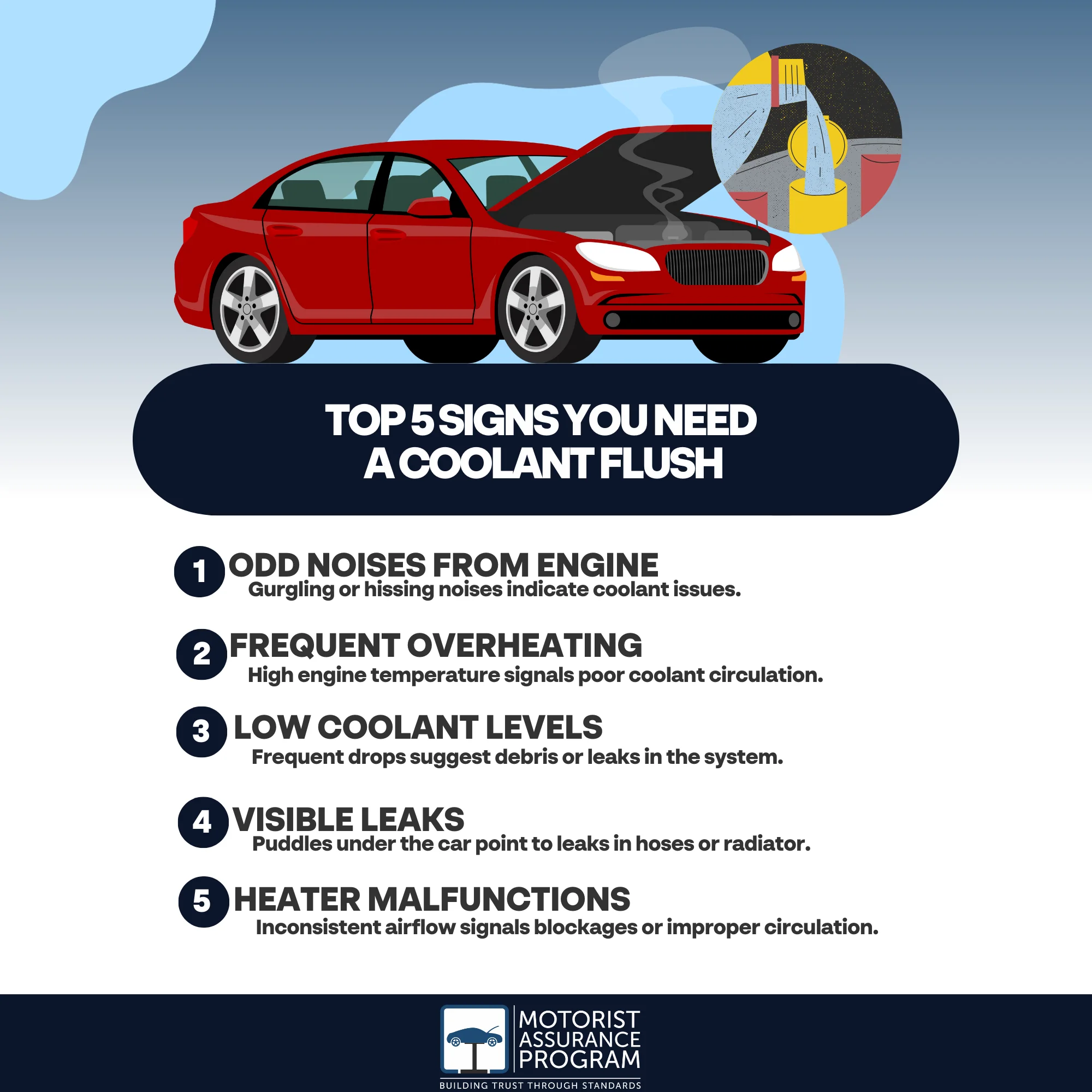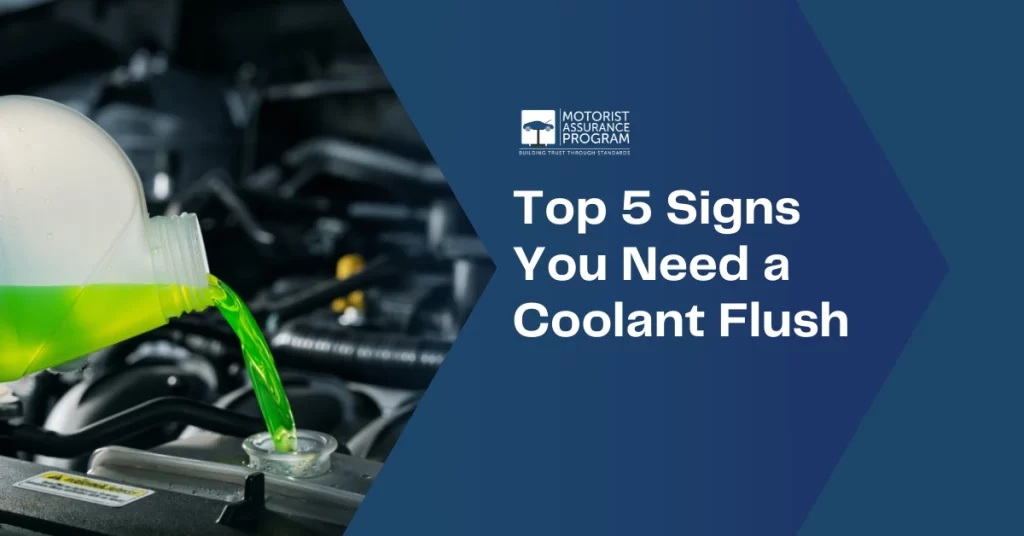If you notice odd noises like gurgling or hissing, it’s time to contemplate a coolant flush. Overheating indicates a malfunction that could stem from contaminated coolant. Keep an eye on low coolant levels; if they drop frequently, a flush may be necessary to remove debris. Look for leaks—puddles under your vehicle can signal significant issues that require attention. Finally, heater malfunctions such as inconsistent airflow might point to poor coolant circulation. Addressing these signs promptly can prevent costly repairs in the future. Discover more about maintaining your cooling system effectively.

Key Takeaways
- Odd noises like gurgling or hissing from the cooling system indicate potential issues needing a coolant flush.
- Overheating engines signal cooling system malfunction and may require a coolant flush to restore proper function.
- Low coolant levels can lead to overheating; a flush can replace old coolant and prevent further issues.
- Frequent coolant leaks or puddles suggest a need for a flush to clear contaminants and restore system efficiency.
- Heater malfunctions, such as inconsistent temperatures, may indicate improper coolant circulation, resolved by a coolant flush.
Odd Noises
When you’re driving, listening for odd noises can be vital for your vehicle’s health. If you hear gurgling, hissing, or bubbling sounds coming from the engine compartment, it could indicate an issue with your cooling system. These noises might be signs you need a coolant flush.
A coolant flush removes old, contaminated coolant that may contain rust, dirt, or other debris. If the coolant isn’t functioning properly, it can lead to overheating and inefficient engine performance. Gurgling noises often suggest air in the cooling system, while hissing may indicate a coolant leak or vaporization due to extreme heat.
Ignoring these sounds can lead to more severe problems, including engine damage. If you notice these odd noises, it’s important to investigate further. Check for any visible leaks or check your coolant level; low levels can exacerbate these issues.
Overheating
Overheating can be a critical warning sign that your engine’s cooling system isn’t functioning properly. When your engine temperature rises above normal, it indicates that the coolant may not be circulating effectively. This can happen for several reasons, including old or contaminated coolant, which can lead to a buildup of sludge and reduce the system’s efficiency.
You might wonder, what does a coolant flush do? A coolant flush cleans out the cooling system, removing debris, rust, and old coolant, allowing new coolant to circulate freely. This process helps restore ideal engine temperature control, preventing damage from overheating.
If you notice your engine overheating, it’s wise to reflect on the coolant flush cost as a preventative measure. While the initial investment may vary depending on your vehicle and service provider, the cost is minimal compared to the potential expenses of engine repairs from overheating issues.
Ignoring the signs of overheating can lead to severe engine damage, so don’t hesitate to address it as soon as possible. Regular maintenance, including coolant flushes, guarantees your cooling system remains effective and your engine stays healthy.
Low Coolant Levels
Low coolant levels can signal serious issues within your vehicle’s cooling system. When you notice this condition, it’s vital to act quickly. Insufficient coolant can lead to overheating, which puts your engine at risk of severe damage. Regularly check your coolant reservoir and ensure it’s filled to the proper level.
If you find low coolant levels, you might need a coolant flush service. This process not only replaces the old, ineffective coolant but also removes any contaminants that could be causing the depletion. Knowing how to flush coolant can save you from costly repairs down the line.
Before performing a coolant flush, consult your vehicle’s manual for the correct type of coolant. It’s important to use the right mixture for peak performance. After flushing, always monitor your coolant levels to ensure they remain stable. If they drop again, it may indicate a more significant problem that requires professional attention.
Leaks
Insufficient coolant levels often point to leaks within your vehicle’s cooling system. If you notice a puddle of coolant under your car or find yourself frequently topping off the reservoir, it’s time to investigate. Leaks can occur in various places, including hoses, the radiator, or the water pump. Identifying the source of the leak is vital to preventing engine overheating and damage.
To locate a leak, start by inspecting hoses for cracks or loose connections. Check the radiator for any signs of corrosion or damage. Don’t forget to examine the water pump, as leaks can develop there too. Once you’ve identified the leak, you’ll need to decide on the right course of action. If it’s a minor issue, you might be able to seal it temporarily. However, significant leaks usually require professional attention.
After addressing any leaks, consider how often you should perform a coolant flush. Typically, it’s recommended every 30,000 miles or as specified in your owner’s manual. If you’re unsure how to do a coolant flush, consult a professional mechanic or refer to your vehicle’s service guide for detailed instructions. Preventing leaks and maintaining proper coolant levels is crucial for your engine’s health.
Heater Malfunctions
One common sign that your vehicle may need a coolant flush is heater malfunctions. If your heater isn’t working correctly, it could indicate that the coolant isn’t circulating properly, often due to contamination or blockages in the coolant system. Ignoring these signs can lead to more severe engine issues, so it’s crucial to address them without delay.
Here are some specific symptoms to look out for:
- Inconsistent Temperature: Your heater blows hot air intermittently.
- Weak Airflow: The heater fan runs, but the airflow is weak.
- Strange Odors: You notice an unusual smell, hinting at a coolant leak.
- Overheating Engine: The engine temperature gauge frequently peaks.
- Coolant Warning Light: The dashboard light indicates low coolant levels.
If you experience any of these issues, it’s time to evaluate a coolant system flush. A coolant flush can remove buildup, enhancing flow and restoring heater function. Don’t wait until the problem worsens; if you need to flush coolant, schedule a service to guarantee your heating system operates efficiently. Keeping your coolant system in check is essential for vehicle performance and comfort.
Frequently Asked Questions
How Often Should I Get a Coolant Flush?
You should get a coolant flush every 30,000 to 50,000 miles, or as recommended by your vehicle’s manufacturer. Regular maintenance prevents overheating and keeps your engine running efficiently, so don’t skip this essential service.
Can I Do a Coolant Flush Myself?
Yes, you can do a coolant flush yourself. Gather the necessary tools, including a drain pan and fresh coolant. Follow your vehicle’s manual for specific steps, ensuring you properly dispose of the old coolant afterward.
What Happens if I Ignore Coolant Flush Needs?
Ignoring coolant flush needs leads to overheating, engine damage, and costly repairs. Regular maintenance guarantees your vehicle runs smoothly, preventing long-term issues that could disrupt your driving experience.
Is Coolant Flush Necessary for Older Vehicles?
Yes, coolant flushes are necessary for older vehicles. They help remove rust, scale, and contaminants, ensuring efficient engine cooling and preventing overheating. Regular maintenance can extend your vehicle’s lifespan and improve performance considerably.
What Type of Coolant Should I Use?
You should use the coolant type specified in your vehicle’s owner’s manual. Typically, it’s either ethylene glycol-based or propylene glycol-based. Ensure it meets the required specifications to guarantee peak engine performance and longevity.
Conclusion
If you notice odd noises from your engine, overheating, low coolant levels, leaks, or heater malfunctions, it’s time to act. Ignoring these signs can lead to a cascade of issues, like a domino effect that topples your vehicle’s performance. A coolant flush is more than a maintenance task; it’s a lifeline for your engine’s health. Don’t let your car suffer in silence—address these symptoms swiftly to keep your ride smooth and your engine running cool.


